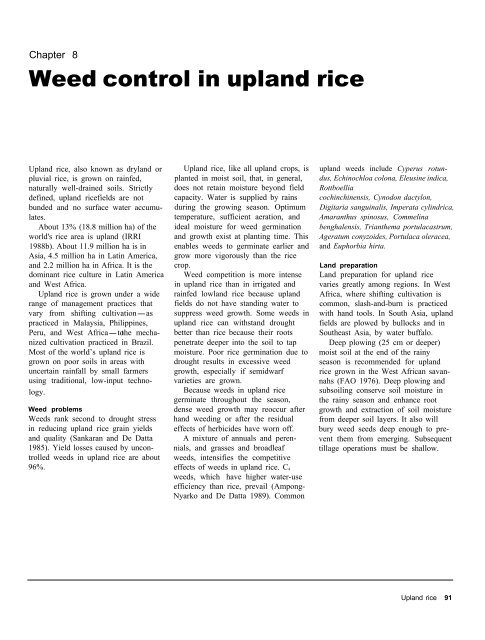A handbbok on Weed Control in Rice.pdf
A handbbok on Weed Control in Rice.pdf
A handbbok on Weed Control in Rice.pdf
Create successful ePaper yourself
Turn your PDF publications into a flip-book with our unique Google optimized e-Paper software.
Chapter 8<br />
<strong>Weed</strong> c<strong>on</strong>trol <strong>in</strong> upland rice<br />
Upland rice, also known as dryland or<br />
pluvial rice, is grown <strong>on</strong> ra<strong>in</strong>fed,<br />
naturally well-dra<strong>in</strong>ed soils. Strictly<br />
def<strong>in</strong>ed, upland ricefields are not<br />
bunded and no surface water accumulates.<br />
About 13% (18.8 milli<strong>on</strong> ha) of the<br />
world's rice area is upland (IRRI<br />
1988b). About 11.9 milli<strong>on</strong> ha is <strong>in</strong><br />
Asia, 4.5 milli<strong>on</strong> ha <strong>in</strong> Lat<strong>in</strong> America,<br />
and 2.2 milli<strong>on</strong> ha <strong>in</strong> Africa. It is the<br />
dom<strong>in</strong>ant rice culture <strong>in</strong> Lat<strong>in</strong> America<br />
and West Africa.<br />
Upland rice is grown under a wide<br />
range of management practices that<br />
vary from shift<strong>in</strong>g cultivati<strong>on</strong>-as<br />
practiced <strong>in</strong> Malaysia, Philipp<strong>in</strong>es,<br />
Peru, and West Africa-to the mechanized<br />
cultivati<strong>on</strong> practiced <strong>in</strong> Brazil.<br />
Most of the world’s upland rice is<br />
grown <strong>on</strong> poor soils <strong>in</strong> areas with<br />
uncerta<strong>in</strong> ra<strong>in</strong>fall by small farmers<br />
us<strong>in</strong>g traditi<strong>on</strong>al, low-<strong>in</strong>put technology.<br />
<strong>Weed</strong> problems<br />
<strong>Weed</strong>s rank sec<strong>on</strong>d to drought stress<br />
<strong>in</strong> reduc<strong>in</strong>g upland rice gra<strong>in</strong> yields<br />
and quality (Sankaran and De Datta<br />
1985). Yield losses caused by unc<strong>on</strong>-<br />
trolled weeds <strong>in</strong> upland rice are about<br />
96%.<br />
Upland rice, like all upland crops, is<br />
planted <strong>in</strong> moist soil, that, <strong>in</strong> general,<br />
does not reta<strong>in</strong> moisture bey<strong>on</strong>d field<br />
capacity. Water is supplied by ra<strong>in</strong>s<br />
dur<strong>in</strong>g the grow<strong>in</strong>g seas<strong>on</strong>. Optimum<br />
temperature, sufficient aerati<strong>on</strong>, and<br />
ideal moisture for weed germ<strong>in</strong>ati<strong>on</strong><br />
and growth exist at plant<strong>in</strong>g time. This<br />
enables weeds to germ<strong>in</strong>ate earlier and<br />
grow more vigorously than the rice<br />
crop.<br />
<strong>Weed</strong> competiti<strong>on</strong> is more <strong>in</strong>tense<br />
<strong>in</strong> upland rice than <strong>in</strong> irrigated and<br />
ra<strong>in</strong>fed lowland rice because upland<br />
fields do not have stand<strong>in</strong>g water to<br />
suppress weed growth. Some weeds <strong>in</strong><br />
upland rice can withstand drought<br />
better than rice because their roots<br />
penetrate deeper <strong>in</strong>to the soil to tap<br />
moisture. Poor rice germ<strong>in</strong>ati<strong>on</strong> due to<br />
drought results <strong>in</strong> excessive weed<br />
growth, especially if semidwarf<br />
varieties are grown.<br />
Because weeds <strong>in</strong> upland rice<br />
germ<strong>in</strong>ate throughout the seas<strong>on</strong>,<br />
dense weed growth may reoccur after<br />
hand weed<strong>in</strong>g or after the residual<br />
effects of herbicides have worn off.<br />
A mixture of annuals and peren-<br />
nials, and grasses and broadleaf<br />
weeds, <strong>in</strong>tensifies the competitive<br />
effects of weeds <strong>in</strong> upland rice. C4<br />
weeds, which have higher water-use<br />
efficiency than rice, prevail (Amp<strong>on</strong>g-<br />
Nyarko and De Datta 1989). Comm<strong>on</strong><br />
upland weeds <strong>in</strong>clude Cyperus rotun-<br />
dus, Ech<strong>in</strong>ochloa col<strong>on</strong>a, Eleus<strong>in</strong>e <strong>in</strong>dica,<br />
Rottboellia<br />
coch<strong>in</strong>ch<strong>in</strong>ensis, Cynod<strong>on</strong> dactyl<strong>on</strong>,<br />
Digitaria sangu<strong>in</strong>alis, Imperata cyl<strong>in</strong>drica,<br />
Amaranthus sp<strong>in</strong>osus, Commel<strong>in</strong>a<br />
benghalensis, Trianthema portulacastrum,<br />
Ageratum c<strong>on</strong>yzoides, Portulaca oleracea,<br />
and Euphorbia hirta.<br />
Land preparati<strong>on</strong><br />
Land preparati<strong>on</strong> for upland rice<br />
varies greatly am<strong>on</strong>g regi<strong>on</strong>s. In West<br />
Africa, where shift<strong>in</strong>g cultivati<strong>on</strong> is<br />
comm<strong>on</strong>, slash-and-burn is practiced<br />
with hand tools. In South Asia, upland<br />
fields are plowed by bullocks and <strong>in</strong><br />
Southeast Asia, by water buffalo.<br />
Deep plow<strong>in</strong>g (25 cm or deeper)<br />
moist soil at the end of the ra<strong>in</strong>y<br />
seas<strong>on</strong> is recommended for upland<br />
rice grown <strong>in</strong> the West African savan-<br />
nahs (FAO 1976). Deep plow<strong>in</strong>g and<br />
subsoil<strong>in</strong>g c<strong>on</strong>serve soil moisture <strong>in</strong><br />
the ra<strong>in</strong>y seas<strong>on</strong> and enhance root<br />
growth and extracti<strong>on</strong> of soil moisture<br />
from deeper soil layers. It also will<br />
bury weed seeds deep enough to pre-<br />
vent them from emerg<strong>in</strong>g. Subsequent<br />
tillage operati<strong>on</strong>s must be shallow.<br />
Upland rice 91











